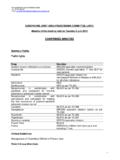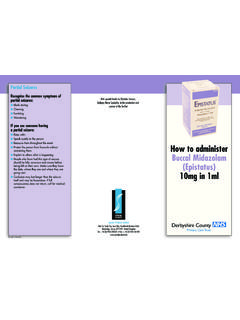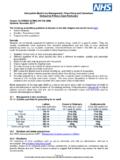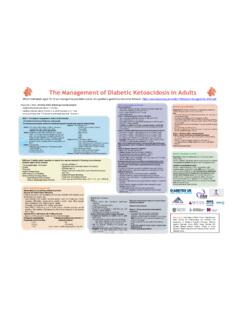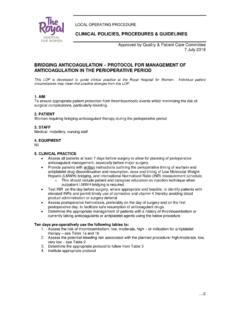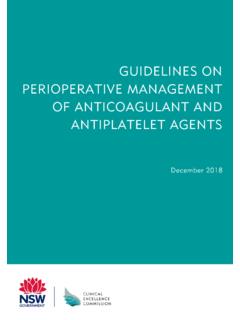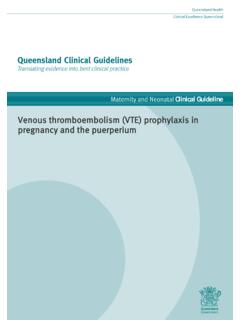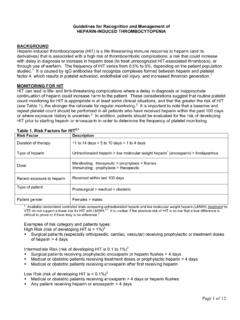Transcription of Guidance on prescribing of Low Molecular Weight Heparin ...
1 DERBYSHIRE JOINT AREA prescribing COMMITTEE. (JAPC). Guidance on prescribing of Low Molecular Weight Heparin (Enoxaparin and Tinzaparin). Introduction Low Molecular Weight Heparin (LMWH) provides effective, rapid anticoagulation and is used in the acute management of venous thromboembolic disease (VTE), often in conjunction with warfarin until INR target is reached. Those who are not suitable for oral anticoagulation may require extended LMWH treatment. The LMWH of choice is enoxaparin (prescribe by brand, preferred cost effective brand Inhixa) at UHDBFT and tinzaparin at CRHFT. Note they are not always used within their licensed indications and there is no LMWH licensed for use in pregnancy. Short courses (up to 6 weeks) of LMWH are provided by the acute hospital trusts for the following indications: Post-operative VTE prophylaxis (eg. post hip/knee replacement). Pre-operative use as warfarin replacement Post-operative use in conjunction with warfarin whilst waiting for the INR to come into range *VTE prophylaxis in post-natal patients (if course length is up to 6 weeks, also see below).
2 Longer courses for the following indications may be continued by GP with little monitoring requirement: Treatment/*Secondary prophylaxis of DVT and PE in patients with cancer, intravenous drug abuse, or intolerance/poor control/failure of oral anticoagulation *Treatment of thromboembolic disease in pregnancy *VTE prophylaxis throughout pregnancy and up to 12 weeks post-partum. Concurrent LMWH during warfarin treatment when patient unexpectedly failed to reach target INR. during loading (DVT/PE within last four weeks) OR INR persistently below target range AND. patient at high risk of VTE mechanical heart valve. small amount only at request of a specialist or INR clinic *unlicensed indications JAPC consensus and agreement for the management of sub-therapeutic INR. 1. It is not uncommon for INRs to fall below the target value in patients taking long-term warfarin. There is though a lack of national Guidance on what to do in this situation.
3 In a patient with a single INR value below therapeutic value, the clinician should check medication compliance with the patient, and investigate any interacting medicines (prescribed, brought over the counter or herbal). Include questions on lifestyle or dietary changes to see if these are the cause. Decide on a patient by patient basis whether to increase the dose and/or address causes and then retest the INR accordingly within the next 3-5 days. In patients with serial INRs (on 3 or more occasions) below therapeutic range where there is no improvement in control following interventions, seek advice from specialists ( in patients with artificial valves). 2. The use of LMWH is only advocated when the warfarin INR falls outside the therapeutic range, within the first four weeks of acute VTE, as recommended by the fourth edition of the British Committee for Standards in Haematology until the patient is within therapeutic range for warfarin.
4 All other patients are deemed low risk. Patients taking warfarin for AF do not require LMWH cover for sub-therapeutic INRs. 3. LMWH is commonly prescribed in patients where rapid thrombolysis is necessary and often used in conjunction with warfarin until target INR is reached. The provider trusts will supply a suitable quantity of LMWH to meet the patients need. However in exceptional circumstances primary care clinicians may be requested to supply small quantities of LMWH where patients fail to reach their target INR at the request of a specialist or INR clinic. Guidance on prescribing of LMWH. Produced: January 2017 Reviewed: January 2019. Next Review Date: December 2020. Page 1 of 4. The following proforma's are examples of the type of information which should be shared with patients GP when requesting continued prescribing of LMWHs Enoxaparin prescribing proforma- prescribe by brand (preferred cost effective brand Inhixa).
5 Patient detail _____ Weight_____kg eGFR_____ml/ Baseline bloods completed Indication Dose _____ IU Duration _____. (please select from below) Dose _____mg Once Twice daily Stop date _____. Treatment/Secondary prophylaxis of DVT and 150 IU per kg ( per kg) 3 months to long term PE in patients with cancer, intravenous drug once daily in uncomplicated abuse, or intolerance/poor control of oral patients with low risk of VTE. anticoagulation recurrence. 100 IU per Kg (1mg per kg) twice daily in all other patients such as those with obesity, with symptomatic PE, cancer, recurrent VTE or proximal (vena iliaca). thrombosis. Treatment of thromboembolic 100 IU per kg (1mg per kg ) Until 6-12 weeks disease in pregnancy twice daily initially, adjusted postpartum according to the antiXa assay VTE prophylaxis in pregnancy 4000 IU- 8000 IU (40-80mg) Throughout pregnancy once or twice daily Concurrent LMWH during warfarin loading when patient unexpectedly failed to reach target INR of _____.
6 (DVT/PE within last four weeks) small amount only at request of a specialist or INR clinic Clinical details and monitoring arrangements must be clearly communicated to GP. 2. Reduce dose if eGFR less than 30 mL/ m specialist advice, consult product literature for details No dose adjustment in moderate or mild renal impairment although careful clinical monitoring is advised. No dose adjustment required for obese patients No routine monitoring required (except post-cardiopulmonary bypass patients) unless clinical condition changes or is likely to change (platelet count, U&Es). 4 weeks enoxaparin supplied Arrangement made for administration (self or district nurse). Tinzaparin prescribing proforma Patient detail _____ Weight_____kg eGFR_____ml/ Baseline bloods completed Indication Dose _____iunits Duration _____. (please select from below). Once Twice daily Stop date _____. Treatment/Secondary prophylaxis of DVT and 175 iunits per kg once 3 months to long term PE in patients with cancer, intravenous drug Daily (doses rounded to the abuse, or intolerance/poor control of oral nearest ).
7 Anticoagulation Treatment of thromboembolic 175 iunits per kg once daily Until 6-12 weeks disease in pregnancy postpartum VTE prophylaxis in pregnancy 3500-4500 iunits Throughout pregnancy once or twice daily Concurrent LMWH during warfarin loading when patient unexpectedly failed to reach target INR of _____. (DVT/PE within last four weeks) small amount only at request of a specialist or INR clinic Clinical details and monitoring arrangements must be clearly communicated to GP. 2. Manufacturer advises caution if eGFR less than 30 mL/ m Treatment dose for patients >165kg - seek specialist advice No routine monitoring required (except post-cardiopulmonary bypass patients) unless clinical condition changes or is likely to change (platelet count, U&Es). 4 weeks tinzaparin supplied Arrangement made for administration (self or district nurse). Guidance on prescribing of LMWH. Produced: January 2017 Reviewed: January 2019.
8 Next Review Date: December 2020. Page 2 of 4. Monitoring BSH guideline 2012 recommends that routine platelet monitoring is not required for LMWH except for cardiopulmonary bypass patients. Responsibility remains with secondary care if monitoring is considered appropriate in the first 14 days of LMWH. No routine monitoring required thereafter. Heparin Induced Thrombocytopenia (HIT). If the platelet count falls by 30% or more and/or the patient develops new thrombosis or skin allergy or any of the other rarer manifestations of HIT between days 4 and 14 of Heparin administration, HIT. should be considered and a clinical assessment made (refer to specialist). Other information Sharps bins will initially be provided by hospital and continued provision will be through the GP. Enoxaparin/ Tinzaparin can be stored at room temperature. Avoid excessive direct sunlight exposure. Contacts Hospital Contacts: Chesterfield Royal Hospital Anticoagulant Clinic 01246 512159 between 9-12am Monday-Friday or Royal Derby Hospital Anticoagulation clinic 01332 789419.
9 DVT clinic 01332 783207. Antenatal clinic 01332 785165. Out of hours contacts and procedures: Pharmacy, UHDBFT, ask for on-call pharmacist via switchboard 01332 340131. Contact the A&E department for any complications such as bleeding Pregnancy triage 01332 786894. Reference SPC Innohep Accessed 8/12/2016. SPC Clexane Accessed 8/12/2016. NICE CG144 Venous thromboembolic disease: diagnosis, management and thrombophilia testing #treatment-2. MHRA Rapid response Report British Society for Haematology's Guidelines on the diagnosis and management of Heparin -induced thrombocytopenia: second edition. Br J Haematol 2012; 159: 528 540. Document produced by Derbyshire Medicines Management Guidelines Group adapted from JAPC shared care Guidance for Low Molecular Weight Heparin (Enoxaparin and Tinzaparin). Document update Date Inhixa as cost effective preferred brand of enoxaparin February 2019.
10 Guidance on prescribing of LMWH. Produced: January 2017 Reviewed: January 2019. Next Review Date: December 2020. Page 3 of 4. Appendix 1. Enoxaparin/ Tinzaparin dosage chart- TREATMENT DOSES. Enoxaparin 150 IU per kg ( per kg) once daily in uncomplicated patients with low risk of VTE recurrence (table below). 100 IU per Kg (1mg per kg) twice daily in all other patients such as those with obesity, with symptomatic PE, cancer, recurrent VTE or proximal (vena iliaca) thrombosis. 60kg dose 6000 IU (60mg) twice daily. Dose: (150IU/kg) SC once daily for treatment of DVT/ PE. Patient Dose in IU Dose in mg Injection Preparation (syringe). Weight SC once daily SC once daily volume (ml). (Kg). 40 6000 IU 60 mg 6000 IU (60mg) / 10,000 IU. 45 6800 IU 68 mg 8000 IU (80mg) / (100mg)/ml 50 7500 IU 75 mg 8000 IU (80mg) / syringe 55 8300 IU 83 mg 10,000 IU (100mg) / 1ml 60 9000 IU 90 mg 10,000 IU (100mg) / 1ml 65 9800 IU 98 mg 1 10,000 IU (100mg) / 1ml 70 10,500 IU 105 mg 12,000 IU (120mg) / 75 11,250 IU mg 12,000 IU (120mg) / 80 12,000 IU 120 mg 12,000 IU (120mg) / 15,000 IU.
